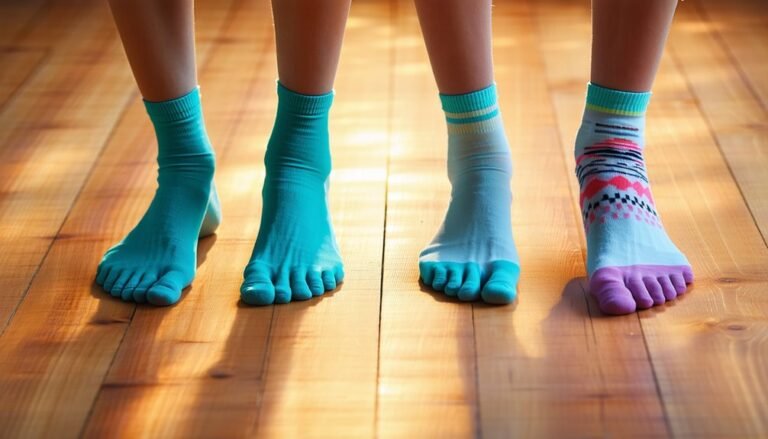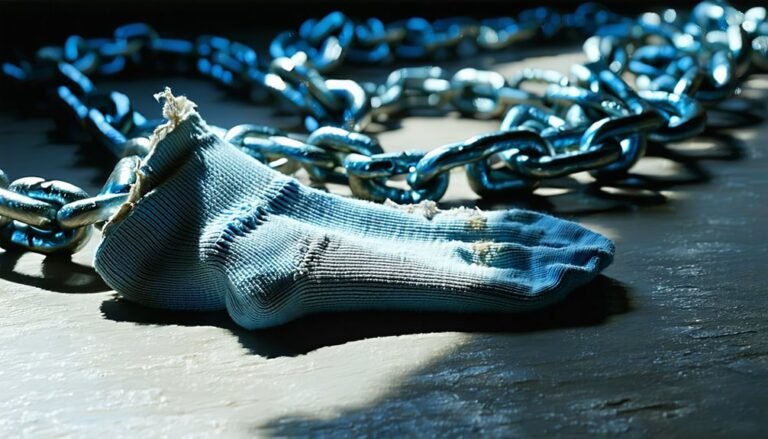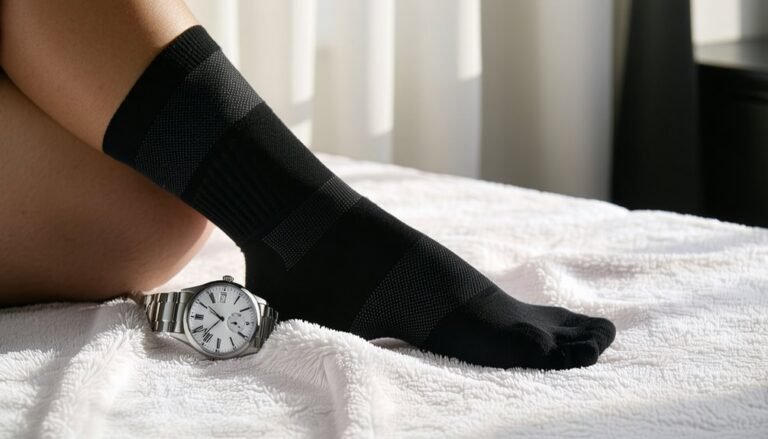Can You Crochet Socks?
Yes, you can crochet socks, skillfully combining yarn weight, hook size, and advanced techniques for a precise fit. Use lightweight yarns with hooks ranging from 2.25mm to 5.5mm for ideal comfort. Master crochet techniques like the magic loop for seamless sections and half double crochet for flexibility. Reinforce heels and toes with stronger yarn for durability. Achieving the perfect fit is possible by mastering tension and sock construction elements. There's more to explore for enhancing your crocheting skills.
The Basics of Crocheting Socks

When starting on the journey of crocheting socks, understanding the fundamental techniques is imperative for success. Begin with selecting appropriate sock yarn, often a blend of fibers providing elasticity and sturdiness. This choice guarantees durability and comfort, essential for foot garments. Mastering crochet techniques like the magic loop method is critical for creating seamless, circular sections. Pay attention to tension control, as consistent tension secures uniform stitches, preventing weak spots that could lead to wear over time.
Utilize advanced stitches such as the half double crochet for flexibility and snug fit. Reinforce the heel and toe areas using stronger yarn, assuring longevity. Safety is paramount; always maintain a well-lit working area to avoid eye strain and keep your crochet tools organized to prevent accidents.
Choosing the Right Yarn and Hook
Having grasped the basics of crocheting socks, the next step involves selecting the right yarn and hook to guarantee your project meets both functional and aesthetic standards. Yarn weight directly influences the sock's thickness and warmth. Choose a lightweight yarn, such as fingering or sport, for a snug fit that won't overheat. Pair this with an appropriate hook size, typically smaller than you'd use for other projects, ensuring tight and uniform stitches to enhance durability. Here's a simple guide:
| Yarn Weight | Recommended Hook Size |
|---|---|
| Fingering | 2.25mm – 3.5mm |
| Sport | 3.5mm – 4.5mm |
| DK | 4.5mm – 5.5mm |
Using the correct combination of yarn weight and hook size is essential for achieving a safe and comfortable fit.
Understanding Sock Construction
When you're crocheting socks, understanding the basic sock anatomy is essential, as it includes elements like the cuff, leg, heel, instep, toe, and foot. Each section requires specific techniques, such as short rows for shaping the heel and various decreases to form a comfortable and snug-fitting toe. Mastering these methods will guarantee your socks are both functional and aesthetically pleasing.
Basic Sock Anatomy
Understanding the fundamental structure of a sock is essential for anyone delving into crochet sock-making. The sock structure typically includes several key components: the cuff, leg, heel, foot, and toe. Each part requires specific stitch types to guarantee durability and comfort. Starting with the cuff, often worked in ribbed stitches, you'll create elasticity to keep the sock in place. The leg portion is commonly crocheted using simple stitches like single or double crochet, providing a snug fit. For the foot section, choose stitches that maintain a smooth texture, guaranteeing safety and comfort for the wearer. By mastering these basic elements, you can confidently create socks that not only fit well but also provide the necessary support and protection for everyday wear.
Heel and Toe Techniques
Master the art of creating crochet socks by focusing on advanced heel and toe techniques, as these are essential for achieving a comfortable fit and durable construction. Begin with the short-row heel technique, which involves working back and forth on a portion of stitches, guaranteeing a snug fit without excess bulk. For added durability, consider incorporating a reinforced heel stitch, offering additional strength where wear is most common.
When addressing toe techniques, the wedge toe method is popular for its seamless decrease, providing a smooth shift and reducing pressure points. Use a fine yarn and a smaller hook size to guarantee a dense, secure fabric. Always prioritize safety by checking tension regularly to prevent tightness that could restrict circulation. These techniques guarantee your crochet socks are both comfortable and long-lasting.
Exploring Sock Crochet Patterns
Diving into the world of sock crochet patterns reveals an array of techniques and styles that challenge even seasoned crocheters. You'll encounter intricate lacework, textured cables, and colorwork that demand precision and mastery. Start with basic crochet techniques like single and double crochet, then advance to more complex stitches such as the shell or puff stitch for added texture. Safety in your work is key; make sure you maintain consistent tension to avoid loose loops that could snag. When selecting sock patterns, consider yarn weight and fiber content to guarantee warmth and durability. Opt for reinforced heel and toe methods for longevity, and always check gauge to match the pattern's requirements. This precision guarantees your socks are both functional and stylish.
Tips for Achieving the Perfect Fit

As you explore intricate sock crochet patterns, achieving the perfect fit becomes essential. Start by creating a gauge swatch to guarantee your stitch tension matches the pattern's specifications. This step is vital for maintaining safety and comfort, as a misfit sock can lead to discomfort or tripping hazards. Use a ruler to precisely measure your swatch, confirming your stitches per inch align perfectly with the pattern. Adjust your hook size if necessary; a tighter stitch tension may require a larger hook, while looser tension benefits from a smaller one. Remember, even slight variations in stitch tension can greatly impact the final sock size. By taking the time to perfect your gauge swatch, you guarantee your handcrafted socks are both safe and snug.
Customizing Your Crocheted Socks
To customize your crocheted socks, start by selecting yarn colors that complement each other and match your wardrobe. Consider the yarn's fiber content, as options like merino wool offer elasticity and warmth. For adjusting sock size, use advanced techniques such as modifying the number of stitches in the cuff or altering the stitch pattern for the foot's circumference.
Choosing Yarn Colors
Have you ever considered how the choice of yarn colors can elevate your crocheted socks from ordinary to extraordinary? Selecting the right color combinations involves more than aesthetics; it's about understanding the interaction between hues. For safety, opt for yarns that are colorfast and free from harmful dyes. Explore seasonal palettes to reflect the time of year—think cozy earth tones for autumn or vibrant florals for spring. When combining colors, use the color wheel to guide complementary and analogous pairings, ensuring that your socks not only catch the eye but also maintain harmony. Additionally, test small samples of your chosen yarns together under various lighting conditions to guarantee the colors blend well and appear as intended.
Adjusting Sock Size
Mastering the art of adjusting sock size is vital for creating perfectly fitting crocheted socks tailored to individual preferences. Begin by making a gauge swatch, a small sample piece, to determine your stitch tension. This step is important as it guarantees your sock will match the pattern's intended dimensions. Use a measuring tape to check the number of stitches per inch in your swatch. If your tension is too loose or tight, adjust your hook size accordingly. A smaller hook tightens the stitch, while a larger one loosens it. Always recheck your gauge swatch after adjustments to maintain safety and prevent ill-fitting socks. By carefully managing your stitch tension, you'll achieve a custom fit, providing comfort and security with every wear.
Frequently Asked Questions
How Do I Care for My Crocheted Socks After They Are Finished?
To care for your crocheted socks, use gentle washing techniques like hand washing with mild detergent. Avoid wringing. For drying methods, lay them flat on a clean towel, reshaping as needed to maintain size and prevent stretching.
Can I Crochet Socks With Toe-Up Instead of Cuff-Down Methods?
Absolutely, you can crochet socks using toe-up patterns! It's like painting a masterpiece from the toes. This method offers flexibility, letting you explore stitch variations for a secure fit, ensuring every step feels like walking on clouds.
Are There Techniques to Make Crocheted Socks More Durable?
To enhance crocheted socks' durability, choose sturdy fabric choices like wool blends. Opt for advanced stitch patterns such as the camel stitch for added strength. Reinforce heels and toes carefully to guarantee lasting wear and safety.
How Can I Prevent My Crocheted Socks From Stretching Out Over Time?
To prevent your crocheted socks from stretching, dance with fiber selection and stitch tension as your partners. Choose resilient fibers with a strong grip and maintain consistent tension, ensuring each loop hugs the previous with secure familiarity.
Is It Possible to Crochet Socks for Individuals With Foot Sensitivities?
Yes, you can crochet socks for those with foot sensitivity by selecting soft, hypoallergenic yarn choices. Use advanced techniques like seamless construction and careful tension control to guarantee a comfortable, irritation-free fit, prioritizing safety and foot health.





